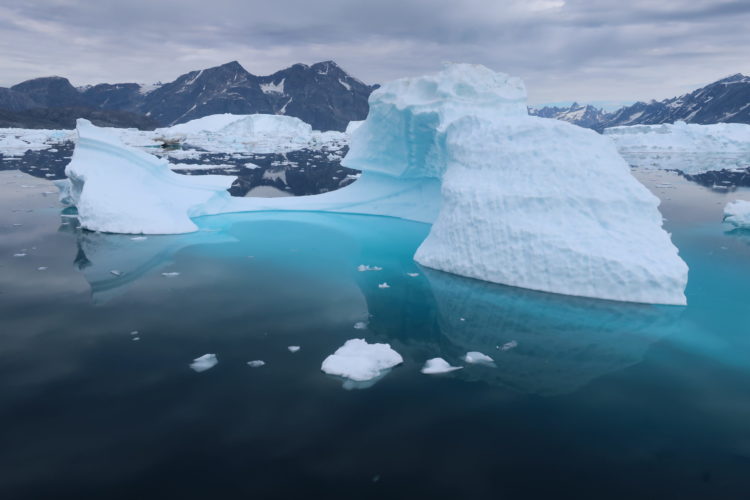Melting icebergs affect oceanic heat delivery towards major glacier

Icebergs are a crucial factor affecting how much heat the ocean delivers towards a major Greenland glacier, according to new research led by the University of St Andrews.
Over the last two decades, Greenland’s tidewater glaciers have retreated, thinned and accelerated dramatically. One of the leading hypotheses seeking to explain this behaviour is that increased submarine melting of tidewater glacier fronts is caused in part by increased oceanic heat transport along glacial fjords, destabilising the tidewater glaciers
However, the new research, funded by the University of St Andrews and the Scottish Alliance for Geoscience, Environment and Society, published in Nature Communications, shows for the first time that icebergs are a crucial factor influencing oceanic heat transport along one of Greenland’s major glacial fjords.
The researchers, including Benjamin Davison and Dr Tom Cowton from the School of Geography and Sustainable Development at the University of St Andrews, Professor Finlo Cottier of the Scottish Association for Marine Science and Dr Andrew Sole of the University of Sheffield, developed a new way of simulating iceberg melting using an ocean circulation model using computing infrastructure at the University of Sheffield.
This model was then applied to Sermilik Fjord, a major fjord in east Greenland, which hosts one of the ice sheet’s largest and fastest tidewater glaciers – Helheim Glacier.
Sermilik Fjord contains many icebergs which melt as they transit the fjord, releasing huge volumes of freshwater. Recent studies have shown that melting icebergs release thousands of litres of freshwater every millisecond into this fjord, comprising a key component of the fjord’s freshwater budget. However, it wasn’t previously known how this freshwater affects oceanic heat delivery to Helheim Glacier.
Counter-intuitively, the researchers found that adding icebergs to the model increased oceanic heat delivery towards Helheim Glacier by around 5 to 50 per cent. This happens because of the interaction between the icebergs and the circulation pattern in Sermilik Fjord.
In Sermilik Fjord, warm, salty water at depth flows towards Helheim Glacier, whilst cool fresh water flows away from the glacier at, and near, the fjord surface. It is the deep, warm water that is responsible for delivering most of the oceanic heat to Helheim Glacier.
Most of the icebergs do not reach down to this warm layer, so they don’t make this layer colder. However, the release of freshwater from the icebergs does invigorate the fjord circulation, making those warm currents faster, ultimately increasing oceanic heat delivery toward the glacier.
Lead researcher, Benjamin Davison, a PhD student in the School of Geography and Sustainable Development at the University of St Andrews, said: “Increased oceanic heat delivery to Greenland’s tidewater glaciers is thought to have been an important driver of their retreat over the past two decades. So there has been a concerted research effort, particularly over the past ten years, to better understand the processes that influence oceanic heat delivery to tidewater glaciers.
“With this work, we’ve shown that submarine iceberg melting is another important process in these fjord systems that can influence oceanic heat delivery towards Greenland’s tidewater glaciers. We therefore think that icebergs are an important component of Greenland’s fjords and should be included in studies of ice sheet-ocean interaction.”
Photo caption: An iceberg in Sermilik Fjord, east Greenland. Please credit © Donald Slater, University of St Andrews
The paper, ‘Iceberg melting substantially modifies oceanic heat flux towards a major Greenlandic tidewater glacier’ by Benjamin Davison, Tom Cowton, Finlo Cottier and Andrew Sole is published in Nature Communications and available online.
Please ensure that the paper’s DOI https://doi.org/10.1038/s41467-020-19805-7 is included in all online stories and social media posts and that Nature Communications is credited as the source.
Issued by the University of St Andrews Communications Office.